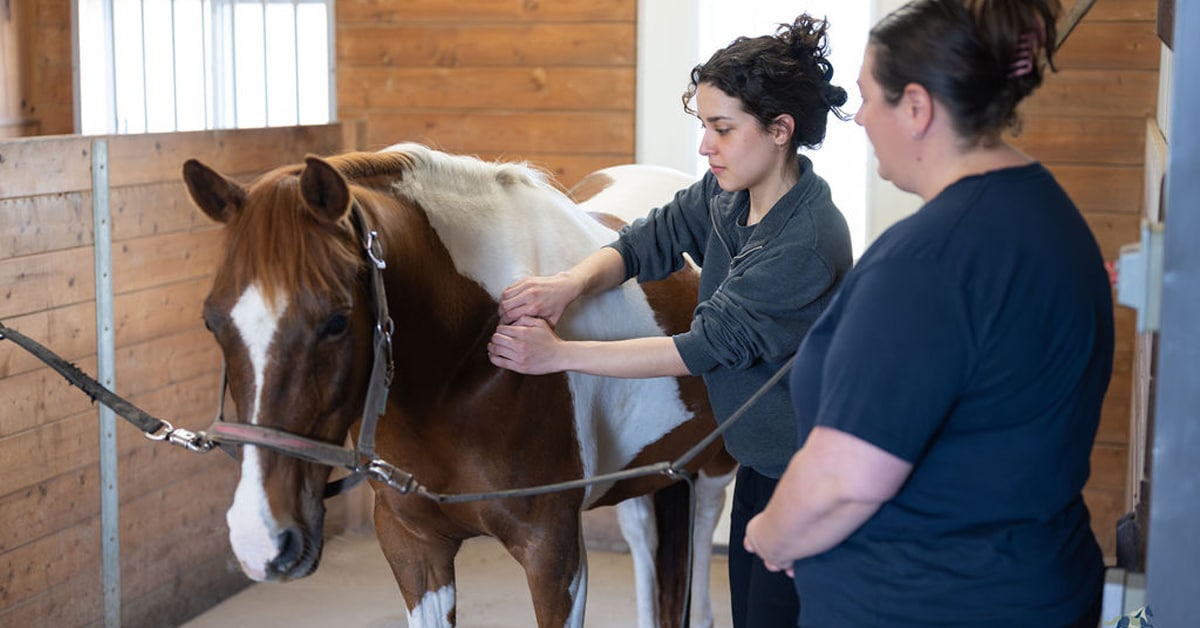Every horse owner wants to avoid having an under-conditioned animal. When unwanted weight loss is observed, there are a few different dietary changes that can be made to combat the issue. A critical first step is to have your veterinarian examine the horse. If there are underlying health issues, or dentition problems, simply adjusting the diet will not fix the root cause of the weight loss.
Recognizing Weight Loss
It is recommended that horse owners regularly body condition score their horse. This involves palpating six key areas on the horse to evaluate fat cover. A score out of nine is then assigned to each body area. The average of these scores will give you your horse’s overall body condition. Performing this regularly allows for more accurate tracking of condition, and often helps owners to notice changes in their horse’s condition earlier on.
In addition to this, evaluating their topline health is also recommended. Far too frequently, horse owners will deem a horse to be underweight when in fact they are at an adequate weight, but have poor topline and muscle development. Recognizing this difference is critical to how you remedy the situation.
A score between four and six on the nine-point Henneke Scale is considered ideal. The ideal score for your horse will depend on a variety of factors such as their type of work and metabolic status. Once you have deemed your horse to be underweight, and health issues have been either ruled out or treated by your veterinarian, it is time to turn to the diet!
Forage & Fibre
If a horse needs to gain weight, their calorie consumption must increase. Horses are fed a variety of forages, commercial feeds and supplements, all with varying caloric content and feeding rates.
Ideally, a horse that needs to gain weight should first and foremost be given free choice access to a quality forage.
A frequent issue is that horses will be transitioned to new hay at the end of the summer and then a sudden drop in weight occurs leading into the winter. When this happens, it is generally due to the forage being lower in digestible energy (DE), which is the caloric content, than the hay the horse was previously fed.
When hay comprises the majority of the diet, understanding if it is high or low energy is critical. To find out the energy content of your hay, it must be sent to a lab for analysis. The DE content of hay varies significantly depending on the species of grasses and legumes present, as well as various harvesting factors such as plant maturity. For easy keepers, a DE content of 1.9 Mcal/kg or below is recommended, whereas if your horse struggles to maintain weight, or needs to gain weight, sourcing hay that is 2 Mcal/kg or above is preferable.
If your hay is of poorer nutritional quality, supplemental fibre can be added with hay cubes, forage pellets, or even a commercial complete feed. For increasing calories, alfalfa is a great choice as it has a greater caloric content than timothy.
Commercial Concentrates
There are many different types of commercial concentrates which can be a great way to add calories to your horse’s nutrition program. However, it is important to select one that is specifically designed to supplement calories. For example, if your horse is maintained on a ration balancer and losing weight, increasing that product will not provide sufficient supplemental calories and could lead to over-supplementation of protein, vitamins and minerals. Therefore, you want to ensure that you are selecting a feed product that has a higher calorie content and is designed to be fed in larger quantities.
Products that work well for calorie supplementation include fat and fibre products, performance feeds, and lifestyle feeds. If you are unsure which type of commercial feed product your horse is currently on, it is recommended to contact the manufacturer and/or a qualified equine nutritionist.
Supplements
Most of the time, weight loss is caught early on, and only minor diet changes are required. If you are happy with the majority of your horse’s current nutrition program and want to start with small changes to increase their calorie intake, supplements can work well. Fat supplements have gained popularity across the industry for a multitude of reasons including weight support, coat health and occasionally anti-inflammatory properties.
Adding 2-4 fl. oz. of oil as a top-dressing on your horse’s daily meals will boost their calorie intake. Although horses do not have a gallbladder, they can digest fats well when introduced to the diet slowly.
A Nutritionist’s Top Tips
1) Regularly body condition score your horse.
2) Consult your veterinarian if any unexpected weight loss presents.
3) Ensure that your horse is fed adequate high-quality forage.
4) Evaluate their commercial feed. Either switch to a higher calorie product, or increase the amount that is fed.
5) Consider adding a high calorie fat supplement such as oil.
6) Consult a qualified equine nutritionist with any additional questions.
Conclusion
Maintaining your horse at an optimal body condition score begins by being able to accurately recognize unwanted changes in their condition. Working closely with your veterinarian to rule out or treat any health conditions is also critical prior to delving into dietary changes.
Overall, increasing the caloric content of the diet is the goal. This can be achieved in a multitude of ways, but adequate quality forage, supplemental fat, and accurately choosing a commercial feed that matches your horse’s nutritional requirements are critical dietary changes to promote weight gain. Please note that every horse is individual, therefore, if you have specific questions, it is recommended to consult a qualified equine nutritionist.
The Latest









